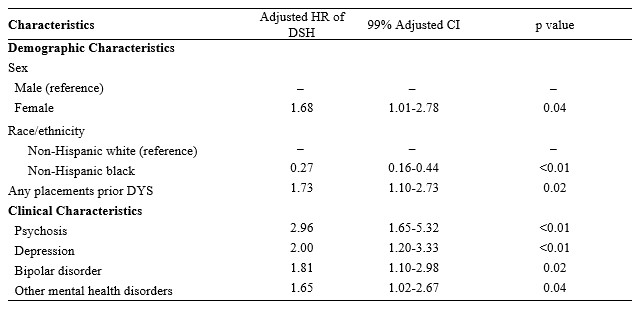Mental Health 3
Session: Mental Health 3
084 - Risk Factors Associated with Deliberate Self-Harm in Youth Previously Incarcerated in the Juvenile Legal System
Monday, April 28, 2025
7:00am - 9:15am HST
Publication Number: 84.6385
Farah Brink, Nationwide Children's Hospital, Columbus, OH, United States; Rui Huang, Nationwide children's hospital, Plain City, OH, United States; Alicia Rodgers, Nationwide Children's Hospital, Reynoldsburg, OH, United States; Danielle L. Steelesmith, Nationwide Children's Hospital, Columbus, OH, United States; Donna Ruch, Nationwide Children's Hospital, Columbus, OH, United States

Farah Brink, MD (she/her/hers)
Assistant Professor
Nationwide Children's Hospital
Columbus, Ohio, United States
Presenting Author(s)
Background: Over 50 000 youth are incarcerated in the United States on any given day. Youth incarceration has been linked to lasting adverse outcomes, including early mortality from suicide. Longitudinal studies of deliberate self-harm (DSH) trends following youth incarceration have not been well-studied. Identifying these associations may inform earlier interventions to reduce self-harm.
Objective: To examine factors associated with DSH in youth following incarceration.
Design/Methods: This retrospective longitudinal population-based cohort study included youth 5-24 years who were incarcerated in Ohio between 2010-2020 and enrolled in Medicaid within two weeks of release. Data was merged from the Department of Youth Services, Ohio Medicaid, and Ohio’s Statewide Automated Child Welfare Information System. Youth were followed from the index date of enrollment after incarceration until the first of study outcomes: DSH, death, or end of Medicaid enrollment. Associations between demographic and clinical characteristics and DSH were analyzed descriptively and with Cox proportional-hazard models using SAS Enterprise Guide 8.3.
Results: Among the 2,542 youth meeting inclusion criteria, the mean age was 17.7 years (SD 1.34 years), 92.3% were male and 55.1% were black. There were 98 instances of DSH observed during the study period. Females had a higher risk of DSH than males, with a hazard ratio (HR) of 1.68 (95% CI: 1.01–2.78). Youth with prior out-of-home placement had 1.73 times the risk of DSH (95% CI: 1.10–2.73). Clinical diagnoses significantly associated with increased risk of DSH included psychosis (HR = 2.96, 95% CI: 1.65–5.32), depression (HR = 2.00, 95% CI: 1.20–3.33), bipolar disorder (HR = 1.81, 95% CI: 1.10–2.98), and other mental health conditions (HR = 1.65, 95% CI: 1.02–2.67). In contrast, Black youth had a significantly reduced risk compared to White youth, with a 73% lower risk (HR = 0.27, 95% CI: 0.16–0.44) (Table 1). The highest risk period for DSH was within the first 200 days following release from incarceration (Figure 1).
Conclusion(s): Characteristics such as having a history of out-of-home placement, diagnoses of psychosis, bipolar disorder and depression were identified as risk factors associated with DSH. Additionally, the risk of DSH was highest within the 6-7 months following incarceration, providing a brief time period for intervention opportunities after release. Knowledge of these risk factors and high-risk period can drive the development of early intervention strategies to decrease the risk of self-harm.
Table 1. Estimated Hazard Ratios of Factors Associated with Deliberate Self-Harm for Youth Following Incarceration in Ohio from 2010-2020.

Cumulative Incidence of Deliberate Self-Harm for Youth After Release from Incarceration
PAS Figure 1 Rplot_day200.jpeg

